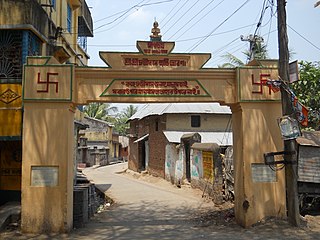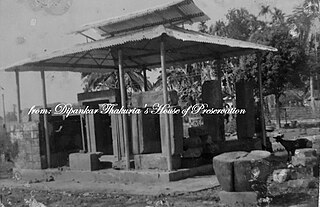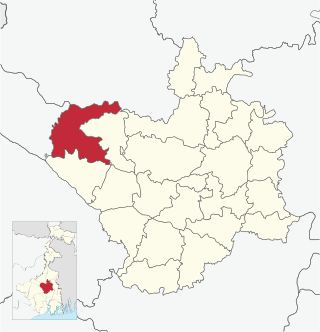The Chalcolithic is an archaeological period characterized by the increasing use of smelted copper. It follows the Neolithic and precedes the Bronze Age. It occurs at different periods in different areas, and is absent in some parts of the world, such as Russia. Stone tools were still predominantly used during this period.

The music of West Bengal includes multiple indigenous musical genres such as Baul, Ramprasadi, Bishnupuri Classical, Kirtan, Shyama Sangeet, Rabindra Sangeet, Nazrul Geeti, Dwijendrageeti, Prabhat Samgiita, Agamani-Vijaya, Patua Sangeet, Gambhira, Bhatiali, Bhawaiya, Bengali Rock.

Mahasthangarh is one of the earliest urban archaeological sites discovered thus far in Bangladesh. The village Mahasthan in Shibganj upazila of Bogra District contains the remains of an ancient city which was called Pundranagara or Paundravardhanapura in the territory of Pundravardhana. A limestone slab bearing six lines in Prakrit in Brahmi script recording a land grant, discovered in 1931, dates Mahasthangarh to at least the 3rd century BCE. It was an important city under the Maurya Empire. The fortified area was in use until the 8th century CE.

Birbhum district is an administrative unit in the Indian state of West Bengal. It is the northernmost district of Burdwan division—one of the five administrative divisions of West Bengal. The district headquarters is in Suri. Other important cities are Bolpur, Rampurhat and Sainthia. Jamtara, Dumka and Pakur districts of the state of Jharkhand lie at the western border of this district; the border in other directions is covered by the districts of Bardhaman and Murshidabad of West Bengal.

Bardhaman district was a district in West Bengal. On 7 April 2017, the district was bifurcated into two districts: Purba Bardhaman and Paschim Bardhaman district. The headquarters of the district was Bardhaman, and it housed the cities of Asansol and Durgapur. Indian revolutionary Rashbehari Bose was born in village Subaldaha, Bardhaman district. Bengali poet Kumud Ranjan Mullick was born at Kogram and poet Kazi Nazrul Islam was born at Churulia in the same district. Notable persons like Prabhat Kumar Mukhopadhyay, Akshay Kumar Datta, Jatindranath Sengupta were also born in erstwhile Bardhaman district. It was the seventh most populous district in India at the time of bifurcation.

Rarh region is a toponym for an area in the Indian subcontinent that lies between the Chota Nagpur Plateau on the West and the Ganges Delta on the East. Although the boundaries of the region have been defined differently according to various sources throughout history, it is mainly coextensive with the state of West Bengal, also comprising parts of the state of Jharkhand in India. Linguistically, the region is defined with population speaking the Rarhi Bengali local Bengali dialect.

Tamralipta or Tamralipti was a port city and capital of Suhma Kingdom in ancient India, located on the coast of the Bay of Bengal. The Tamluk town in present-day Purba Medinipur, West Bengal, is generally identified as the site of Tamralipti.

State Archaeological Museum in Kolkata, West Bengal, is an archeological museum founded in 1962 and has collections including rare tools of the Early, Middle and the Late Stone Ages from Susunia (Bankura) and other sites, proto-historic antiquities from Pandu Rajar Dhibi (Burdwan), terracottas, sculptures, stone and stucco from the Gupta, Maurya, Shunga, Kushana, Pala and Medieval times. It is located at the vicinity of Behala Bazar Metro on Diamond Harbour Road and Nafar Chandra Das Road at Behala behind Siddeshwari Kali Temple

The Wari-Bateshwar ruins in Narsingdi, Dhaka Division, Bangladesh is one of the oldest urban archaeological sites in Bangladesh. Excavation in the site unearthed a fortified urban center, paved roads and suburban dwelling. The site was primarily occupied during the Iron Age, from 400 to 100 BCE, as evidenced by the abundance of punch-marked coins and Northern Black Polished Ware (NBPW) artifacts.

Nanoor, is a village in Nanoor CD block in Bolpur subdivision of Birbhum district in West Bengal. Nanoor is the birthplace of 14th century lyric poet Chandidas of Vaishnava Padavali fame. It is developing as a craft centre with NGO support. With the massacres in 2000, Nanoor was in intense media focus.

Chand Sadagar was a rich and powerful sea merchant of Champaknagar in Eastern India. This merchant has been claimed by both the Assamese and Bengali people of India to be associated with their respective states and communities. Medieval Bengali poet Bipradas Pipilai mentioned in his "Manasamangal Kāvya" that merchant ship of Chand Sadagar used to proceed to the sea from ancient Champaknagar of Kamarupa after passing through Tribeni, situated at the junction of Saptagram and the confluence of Ganges, Saraswati and Jamuna River of modern-day West Bengal. Narayan Dev in the Assamese scriptures gave an account in his Manasamangal about the merchant ship of the trader Chand Saudagar proceeding to the sea from ancient Champaknagar of Assam passing through Saptagram and Tribeni, the tri-junction of the Ganges, Saraswati and Jamuna River. In the Padmapuran, account of Chand Bania (Sadagar) is specifically mentioned.
Kunur River, one of the main tributaries of the Ajay, 112 kilometres (70 mi) in length, has its origin near Bansgara in the Faridpur police station area. With water from several small streams swelling it during the monsoons, it often floods large areas of the Ausgram community blocks and Mangalkot police stations of Bardhaman district. It joins the Ajay near Ujani village.
Dihar is a village and an ancient archaeological site of great antiquarian importance brought into the limelight by Maniklal Sinha. Located in the Bishnupur subdivision of the Bankura district in the Indian state of West Bengal. It is 8 kilometres (5.0 mi) north of Bishnupur and is near Dharapat.
Balathal is an archaeological site located in Vallabhnagar tehsil of Udaipur district of Rajasthan state in western India. It is one of the ninety Ahar-Banas culture sites located in the Basins of the Banas river and its tributaries.

Ausgram II is a community development block that forms an administrative division in Bardhaman Sadar North subdivision of Purba Bardhaman district in the Indian state of West Bengal.

Purba Bardhaman district is in West Bengal. Its headquarters is in Bardhaman. It was formed on 7 April 2017 after the division of the previous Bardhaman district. Great revolutionary Rash Behari Bose was born in village Subaldaha in the district of Purba Bardhaman.

The history of West Bengal basically refers to the history of the western part of Bengal, located in the eastern part of the Indian subcontinent. Evidence of human settlement has been found in West Bengal about 42,000 years ago. The presence of human settlement of that period has been found in the Ayodhya Hills of West Bengal. By 2,000 BCE, settled life had increasingly spread of human civilization in the Damodar-Ajay River Valley, which was contemporary with the Harappa-Mahenjodaro civilization. The southern part of West Bengal witnessed the presence of the Vanga Kingdom between 1100 BCE and 350 BCE, which was contemporary with the Vedic civilization of northern India.
Mongalkote archaeological site is located in Purba Bardhaman district of West Bengal. Archeological excavations have revealed seven phases of cultural significance between 2000 BC to 1800 AD. After a detailed study of all the finds from this region, it has been possible to determine seven levels of human settlement. Period I represent the Chalcolithic era; Period II agricultural era; Period III is the Maurya-Sunga period; Period IV relates to the Kusana period; Period V is the Gupta era; And Periods VI and VI are the medieval period.
Early Agricultural Communities in Bengal were a group of Chalcolithic farmers, who first developed agriculture in Bengal. No archaeological evidence of large-scale agriculture in Bengal during the Neolithic period preceding the Chalcolithic or Copper Age.
Dihar is an archaeological site of Neolithic and Early village farming culture located in the Indian state of West Bengal. Construction of the settlement is believed to have started around 2700 BC. Dihar people developed a system of exploitation of natural resources and subsequent commercialization of commodities. The financial security afforded by this system encouraged artistic excellence in pottery making and bone-working.
















